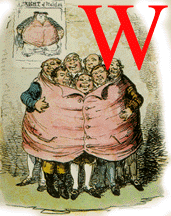
illiam Makepeace Thackeray and Charles Dickens are often regarded as rivals, and there is plenty of evidence to suggest that they viewed each other in these terms. Nevertheless, their work overlaps in many ways, and they undoubtedly shared a great deal of common ground. One of their interests was the engagement with contemporary visual culture. Both authors responded to, and were actively involved in, the construction of this discourse, notably in the form of art reviews and commentaries. Thackeray wrote, among others, an analysis of J. W. M. Turner’s Rain, Steam and Speed (1844), and in his ‘Old Lamps for New Ones’ Dickens famously ridiculed J. E. Millais’s Christ in the House of His Parents (1849–50), reserving his hardest comments for what he regarded as the vulgarity of Pre-Raphaelite realism. But it was illustration that most exercised the writers’ critical faculties. Thackeray presented an extended reading of George Cruikshank’s designs in The Westminster Review (1840), and in an article on Gustave Doré’s Don Quixote in All the Year Round Dickens caustically remarked on what he saw as the deadening influence of ‘The Sixties’ school (1867).
Of course, illustration was a natural subject for both authors because each specialized in illustrated fictions. Deeply concerned with the aesthetics and function of interpretive design, Dickens and Thackeray were the prime movers in the development of the illustrated novel, laying the foundation stone for a mode of publication that was adopted by practically every major writer of the period. Each dealt with the artistic collaborators who materialized their words and each engaged in complex relationships in which they manipulated their partners’ responses. Dickens managed the efforts of Cruikshank, H. K. Browne, John Leech, Daniel Maclise and others; and Thackeray struggled to control those recalcitrant and difficult collaborators, Richard Doyle and Frederick Walker.
However, Thackeray differs from Dickens in that he not only dealt with illustrators but illustrated much of his work for himself. This capacity to visualize his own words places him in a unique or near-unique position at the heart of the mid-Victorian debate which questioned the dynamics of the sister arts. Of course, they were others who illustrated their own writing or wrote words to match their images. Among these artist-writers were Christina Rossetti, whose sketchy designs were intended as guidance for Arthur Hughes; Charles Bennett, the writer and designer of satirical comic books; and Charles Kingsley, another amateur artist with strong views on the role of illustration. However, Thackeray’s achievement as an artist/author is complex and sustained, and far superior to that of any of his contemporaries. As Gordon Ray comments, ‘his achievement as an illustrator [surpassed] that of any other [writer]’ of the period, and his illustrations ‘have the transcending merit of coming directly from the mind that created the work being illustrated’ (p.74).
Thackeray’s engagement with illustration might thus be conceptualized in terms of the workings of the texts he illustrated for himself, and the texts illustrated by others. This vast and complicated subject has been explored in sundry commentaries. His visual strategies are considered in detail in John Harvey’s analysis of the illustrated novel (1970), and again in articles and chapters by Joan Stevens (1965, 1974) and Judith Fisher (1995). His collaborations with Doyle and Walker have also been examined at length, notably in the form of commentaries by Viola Hopkins Winner (1978), John Olmsted (1978), Simon Cooke (2010), Anthony Burton (1974) and John Buchanan-Brown (1979).
This criticism is wide-ranging but disparate. The aim in the essays collected here is to draw together the threads of Thackeray’s involvement with illustration, focusing not only on the two strands in the showing of his work, but also on his graphic style and the ways in which his views on illustration informed his own practice.
Works Cited
Buchanan-Brown, John. The Illustrations of Thackeray. Newton Abbot: David & Charles, 1979.
Burton, Anthony. ‘Thackeray’s Collaborations with Cruikshank, Doyle, and Walker.’ Costerus n.s. 2 (1974):141–87.
Dickens, Charles. ‘Book Illustrations.’ All the Year Round10 August 1867; reproduced in Studies in Illustration 49 (Winter 2011): 15 –22.
Dickens, Charles. ‘Old Lamps for New Ones.’ Household Words 15 June 1850: 265–67.
Fisher, Judith. ‘Image versus Text in the Illustrated Novels of William Makepeace Thackeray.’ Victorian Literature and the Victorian Visual Imagination. Eds. Carol T. Christ and John O. Jordan. Berkeley: University of California Press, 1995. pp. 60–87.
Ray, Gordon. The Illustrator and the Book in England from 1790 to 1914. New York: Pierpont Morgan Library, 1976.
Harvey, John. Victorian Novelists and Their Illustrators. London: Sidgwick & Jackson, 1970.
Olmsted, John C. ‘Richard Doyle’s Illustrations for The Newcomes.’ Studies in the Novel 13 (1978); 93–108.
Stevens, Joan. ‘Thackeray’s Pictorial Capitals.’ Costerus n.s. 2 (1974): 114–40.
Stevens, Joan. ‘Thackeray’s Vanity Fair. ’ Review of English Literature 6 (1965): 19–38.
Thackeray, W.M. An Essay on the Genius of George Cruikshank. London: Henry Hooper, 1840.
Winner, Viola Hopkins. ‘Thackeray and Richard Doyle, the “Wayward Artist” of The Newcomes. ’ Harvard Library Bulletin 26 (1978): 193–211.
Last modified 15 October 2014